
Blade changing reduced with grit-edge blades
Forcible entry is an intricate part of most firefighting operations. Whether it’s done through the lock (see FIRE ENGINEERING, July 1984) or with a more involved method (such as a triangle cut for higher security steel rollups), without access to the fire area, risk factors would soon reach unacceptable levels.
Once inside the fire building, the heat and smoke levels that firefighters must contend with might also reach unacceptable levels unless vertical ventilation is quickly and properly executed.
One of the tools often used for both involved forcible entry and vertical ventilation is the circular power saw. This tool has more than proved its worth in emergency situations by cutting through padlocks and wooden roofs in less time than it would take a prying tool or axe.
The time loss with a saw comes when blades have to be changed, either because what you thought was a wooden roof turned out to be sheetmetal and the saw blade’s teeth became chipped, or because the blade’s teeth become so gum filled as to be useless.
This problem can be alleviated somewhat by a gritedge circular blade. Manufactured by the Abrasive Products Division of Remington Arms Company Inc., a division of DuPont, the blade cuts with particles of tungsten carbide grit bonded to alloy steel. Although this particular blade was developed in 1965 and has been used for 20 years by heavy industry, it was recently eyed for possible application within the fire service.
Tested by Bridgeport, CT, Rescue Squad 5, which averages more than 2,000 runs each year, the blade is reported to cut metal and, to a lesser degree, wood, aluminum, fiberglass, and other materials. Although softer materials may load up the blade, subsequent use on hard/abrasive materials or with solvent and a wire brush restores much of the blade’s cutting ability.

Photo courtesy of Remington Arms Company Inc.
Used over a nine-month period by four on-duty shifts and in training sessions, the blade has cut through corrugated steel doors, tractor-trailer skins, security bars on windows, and case-hardened steel hasps. During this time, the blade was replaced only once. Its relatively long life as compared to conventional circular power saw blades is attributed to the grit-edge blade having no teeth to dull, chip, or fill. Also, the blade can be reversed when it begins to wear in one direction, providing up to 25% additional life, according to the manufacturer.
The tungsten carbide grit has also been bonded to rod saws, which are required in some states to be carried on emergency rescue vehicles. Since the grid covers all surfaces of the steel rod, it can cut in difficult and awkward locations. The rod saw can cut bolts, chain link fences, thin gauge steel, concrete, and brick.


